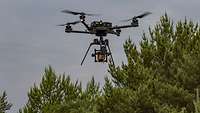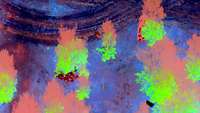Better reconnaissance with modern UAVUnmanned Aerial Vehicle sensor systems
Better reconnaissance with modern UAVUnmanned Aerial Vehicle sensor systems
- Date:
- Reading time:
- 2 MIN
In June 2023, a team of the Bundeswehr Technical Centre for Aircraft and Aeronautical Equipment (WTDWehrtechnische Dienststelle 61) from Manching in Bavaria, together with the Bundeswehr University (BwU) Munich and other partners from the Bundeswehr, tested what is known as hyperspectral sensor systems.
Hyperspectral images provide more information
The human eye processes the primary colours red, green and blue all at the same time and cannot – or only to a limited extent – separate them into individual spectral ranges.
What is special about hyperspectral sensor systems is that they split the colour information of the environment into very fine nuances and display this information separately. Several hundred narrowband channels can thus collect significantly more information from the environment than, for example, a common three-channel colour image consisting of red, green and blue.
Among other purposes, this technology is already used in satellites for earth observation.
The detailed environmental information obtained by means of hyperspectral sensor systems can, for example, improve the detection of potential targets such as vehicles and equipment.
Several research and technology projects currently examine in which areas the compact sensor systems might be used in the Bundeswehr.
Aerial testing
During the tests at a training area in Brandenburg, several different drones and sensors were flown over various kinds of large and small targets, which were also measured on the ground while stationary. The spectrum of reconnaissance targets ranged from vehicles to mock-up antitank mines and camouflage nets.
During the three test days, the team employed four different multispectral and hyperspectral sensor systems. Each of these differed in their spectral resolution. At the same time, a UAVUnmanned Aerial Vehicle taking video and photo material was constantly in the air for documentation purposes during the test flights. The analysis of the several hundred gigabytes of collected data began after the tests had been completed.
The team of WTDWehrtechnische Dienststelle 61 and BwU was supported in the complex testing procedures by the Bundeswehr Signals Intelligence Technical Analysis Centre in Hof, Bavaria, the Army ISRIntelligence, Surveillance and Reconnaissance School in Munster, Lower Saxony, and the Bundeswehr Technical Centre for Protective and Special Technologies in Oberjettenberg, Upper Bavaria (WTDWehrtechnische Dienststelle 52).




